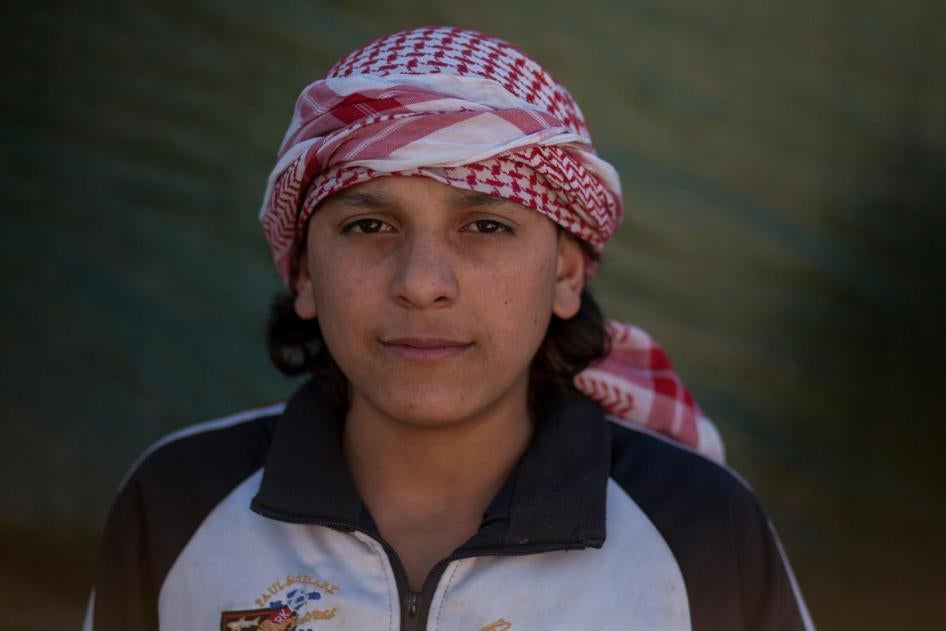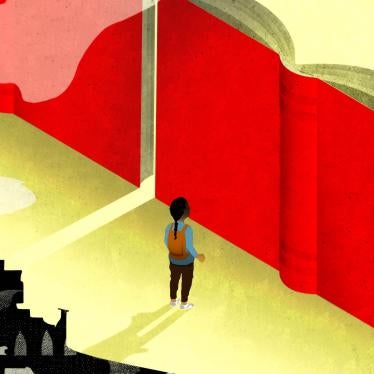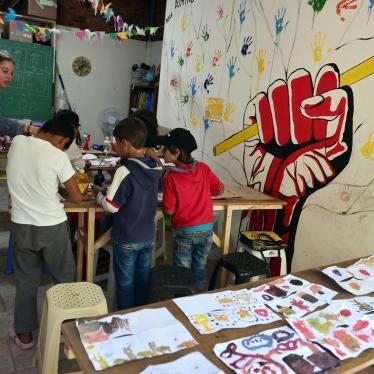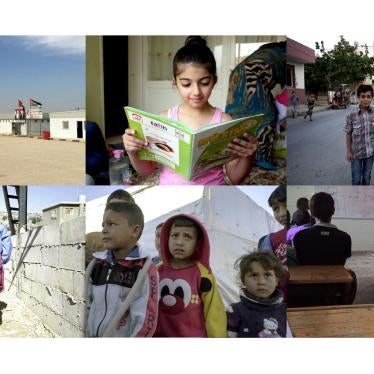Amin, 18, became a refugee when his family fled Syria for Lebanon five years ago. He has not set foot in school since. With his father unable to get legal status or work, responsibility for supporting the family of seven fell to Amin. A seventh grader when he left his school in Homs, he became a construction worker at age 13, hauling cement blocks for apartment buildings. “I’ve been here five years and lost five years of my life,” he said.
Every day in 2015, around 17,000 children fled their homes due to persecution and conflict. Forcibly displaced children, including refugees, have the right to available and accessible quality secondary education, without discrimination. School can protect them, set a normal routine vital to healing, create economic opportunities, and nurture hope.
But for many older children, going to school is impossible.
According to the United Nations Refugee Agency (UNHCR), half of the world’s 3.5 million refugee children of primary-school age attend classes, but fewer than a quarter of the 1.95 million secondary-school aged children do. In countries like Pakistan and Lebanon, enrolment falls to just 5 percent.
It is worse for girls: globally, just 7 girls for every 10 refugee boys go to secondary school. Forcibly displaced children with disabilities are often excluded altogether.
The problems, and solutions, are at root about funding and refugee policies. Globally, less than 2 percent of donor support goes to education in emergencies; of that, far more goes to primary than secondary education. Inadequate resources coincide with restrictive refugee host-country policies that often hit children hardest as they become adolescents. Some host countries simply deny them the right to enrol in secondary schools outside refugee camps.
Children with secondary education are typically healthier, and likelier to find work as adults and escape poverty. Those who drop out of school may face hazardous labour, child marriage and sexual violence, harassment by state security forces, and targeting and recruitment by armed groups.
Failure by donors and host countries to ensure secondary education for displaced children and adolescents risks undermining economic development. It also robs secondary school-aged children of the skills they need to contribute to host communities, and if they return home — with repercussions for security and stability.
Secondary education and conflict
Education promotes stability: it provides children with tools for resolving disputes peacefully, and increases productivity. Quality secondary education has been shown to promote tolerance, foster a stronger belief in democracy, and help resist recruitment to violent extremism.
High secondary school enrolment levels may even lower the probability of civil war, while failure to provide education for displaced adolescents in crises can hamper reconstruction efforts.
Yet education is often a casualty when children are forced to flee for safety. Children and their families have fled Somalia due to forced recruitment and abduction of children by parties to the conflict. School dropout rates reportedly reached 50 percent in 2010.
The impact of conflict is especially hard on secondary education, which needs specialised resources, including teachers, that are hard to get in crises. And forcibly displaced adolescents who drop out of school are unlikely to return.
Some governmental responses have only made matters worse.
In Nigeria, the government has not adequately protected schools from attacks by the extremist group Boko Haram (“western education is forbidden”). One teacher told Human Rights Watch in 2015 that his secondary school had become “a Boko Haram slaughtering ground… anyone they caught, they will bring to the school and kill them.” In conflict-affected states, fewer than 90,000 of nearly 590,000 displaced school-age children can access education.
Compounding the problem, Nigeria’s government has closed both primary and secondary schools in order for security forces to use them as operations posts or barracks, violating its own commitment to the Safe Schools Declaration signed in 2015.
Overlooked and underfunded
In survey after survey, refugees identify education as a critical need, on which many spend large portions of their incomes. Others take enormous risks: one woman returned to Syria after being unable to enrol her children in Lebanese schools despite the danger. “Education is the only goal,” she told Human Rights Watch.
Yet education’s share of donor aid is paltry, falling, and fails to reach many children. Less than a quarter of overseas development aid is disbursed to low-income countries, which host 86 percent of the world’s refugees. And some long-term crises are permanently underfunded, as money skews towards the latest, most visible emergencies. Many grants last only 12 months.
Of the limited funds available for education, primary education receives the lion’s share, with secondary an afterthought despite the need for more textbooks, classrooms, equipment, and highly-qualified teachers. In 2015, for example, UNHCR allocated just 13 percent of its education budget to secondary education, one-third of what it spent on primary.
Agencies do not necessarily have as much programming for secondary education as they do for younger children. Humanitarian actors are still playing catch-up when it comes to secondary education.
In Lebanon, the Education Ministry and UNHCR set a target last year of enrolling nearly 200,000 Syrian refugee children in public primary schools, but just 2,080 in public secondary schools, out of nearly 83,000 secondary-age children.
Bureaucratic barriers
Bureaucracy can often hamper access to secondary education.
Secondary school-age children who have been forcibly displaced have been barred from education because they lack official documentation. In Lebanon, children turning 15 must pay $200 — often a prohibitive sum — to renew their residency, and many lack the required documents. In Turkey, Syrian refugee children must obtain an “identification” to enrol in schools, but the wait often lasts half a year.
Some Syrian adolescents gave up trying to re-enrol in secondary school after years trying to meet inflexible requirements. Amal, 20, said she had completed all her high school exams “except the very last one” before her family fled Syria, but when she tried to finish her exams in Jordan, Education Ministry officials repeatedly refused. “They said they needed proof I had passed 11th grade, but they wouldn’t accept my faxed form, and told me I needed to send in the original.” Not only would she have to return to war-torn Syria to obtain it, “but the border is closed.”
In Lebanon, refugee children must provide 9th grade transcripts to enrol in secondary school, which many left behind while fleeing the war in Syria. And some school officials refuse to accommodate them. Sixteen-year-old Loreen has been out of school since heavy shelling cut her off from the 7th grade in Syria. When she tried to enrol in Turkey, the school director said she would “have to join her age group, no exceptions,” even though she spoke no Turkish. When her mother asked the school about language help, she was told “there wasn’t any.” Loreen now works full-time in a dried-fruit factory.
Barriers to girls’ education
Crises can exacerbate the hurdles girls face to secondary school, including sexual and gender-based violence, and early pregnancy and marriage.
In Afghanistan, Taliban forces targeted girls’ education after being forced from power in 2001; by 2004, only 5 percent of Afghan girls attended secondary schools, and attacks increased thereafter. Taliban forces threatened girls to stop attending school past puberty, shot students and teachers, threw battery acid in the faces of adolescent schoolgirls, burned their schools and attacked them with rockets and explosives.
In situations of forced displacement, parents may marry off girls to cope with poverty or safety concerns, and most married girls stop going to school. Child marriage has leapt four-fold among Syrian refugee girls in Lebanon, Turkey, and Jordan.
Conversely, secondary education can be life-changing for girls, with potential gains for host countries and overall development. It can reduce childhood deaths because children with higher education levels are more likely to have a healthy diet and seek medical care, and girls with secondary education are less likely to marry early.
Poverty and child labour
Poverty — exacerbated by policies that prevent parents from finding work — pushes school out of reach for many displaced children. Pressure to earn intensifies as children grow. In any case, many families cannot afford secondary-school fees, uniforms, notebooks, and higher transport costs, since secondary schools are often fewer and farther away.
Children who leave school to work are at risk of serious harm: exploitation, hazardous work environments, or violence. Lebanon saw a sharp increase in the worst forms of child labour among refugee children in 2015, and children have been injured, attacked, or arrested while working.
When there are few opportunities for skilled work or higher education — like in Kenya’s Dadaab camp, where just 13 percent of adolescents attend secondary schools — there is far less incentive to get a secondary education. A UN survey in Zaatari, Jordan’s largest refugee camp, found that barriers to education included “a sense of the pointlessness of education as [Syrian children] had limited hope for their future prospects.”
Allowing refugees to work could ameliorate poverty’s knock-on effects on secondary education. Host countries may fear that refugees will take citizens’ jobs, but refugees often take jobs that nationals do not want, and labour protections could help stem the downward pressure on wages that results from informal work.
Even in countries that have opened access to work permits for refugees, like Turkey, restrictions — such as quotas, geographical restrictions and permits tied to local sponsorship — often remain. Syrian refugees in Lebanon, denied the opportunity to work legally and dependent on insufficient aid, have sunk deeper into poverty, making it harder to afford to send children to school.
Alternatives are possible. In Uganda, 500,000 refugees are allowed to work and access public schools, and only 1 percent rely completely on aid.
Global response
It has taken decades for the global community to recognise the importance of education in humanitarian response, but recent promises could help displaced children—if they are kept.
In May 2016, humanitarian donors and UN agencies launched Education Cannot Wait, a global fund that aims to support education for 75 million children and young people affected by emergencies each year, looking to raise $3.85 billion by 2020.
In September 2016, countries pledged to improve access to lawful work for 1 million refugees, and access to education for 1 million refugee children. The UN Global Commission on Education has set specific goals and timelines for governments to achieve free, equitable, and quality secondary education for all by 2030, a target that all UN member states pledged to meet as one of 17 Sustainable Development Goals.
But the good news must be taken with a grain of salt. Donor attention to education has proved fickle before; in 2010, funding dedicated to education decreased dramatically when donors reduced aid budgets or diverted funds to other sectors. And greater transparency is needed to hold donors to their promises.
Ways forward
It is essential for governments affected by crises to protect secondary education from attack, create safe alternatives, and ensure their forces refrain from the military use of schools.
Governments and humanitarian actors need to address barriers that cause older displaced children to drop out, including girls and children with disabilities, and make secondary education an integral part of response plans to crises. Transparent, sustained, multi-year funding is urgently needed to ensure children can access and complete secondary school.
To enable families to pay school-related costs, host countries should allow refugees access to lawful work. Donors should fund livelihood efforts so that families do not have to rely on child labour and can send secondary-age children to school.
Governments hosting foreign children should provide legal access to secondary education or vocational and skills training on an equal basis with nationals, and de-link immigration-related requirements such as residence permits from enrolment criteria.
Host countries should ensure national education plans include refugee children, and accommodate them with flexible enrolment requirements. Administering placement exams, in lieu of requiring transcripts, is one simple way to ensure children are not excluded from secondary education due to factors beyond their control.
Host countries must recognise that older children deserve the same protection and support offered to primary school age children, and above all need to be in school. Continuing to ignore their needs would be a grave mistake.












